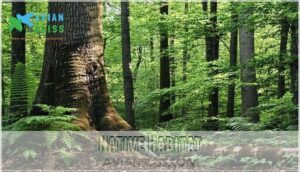This site is supported by our readers. We may earn a commission, at no cost to you, if you purchase through links.
 The ivory billed woodpecker, North America’s largest woodpecker, vanished from sight in 1944 after habitat destruction and hunting decimated populations.
The ivory billed woodpecker, North America’s largest woodpecker, vanished from sight in 1944 after habitat destruction and hunting decimated populations.
You’d recognize this "ghost bird" by its striking black-and-white plumage, brilliant red crest, and massive ivory-colored bill that earned its name.
Once thriving in old-growth forests across the southeastern United States, it’s now considered functionally extinct—though recent grainy footage from Louisiana swamps has federal officials postponing extinction declarations.
These magnificent birds served as forest architects, creating cavities that sheltered dozens of other species while foraging for beetle larvae in dying trees.
Their story reveals how quickly we can lose irreplaceable species when pristine habitats disappear.
Table Of Contents
- Key Takeaways
- Ivory Billed Woodpecker Basics
- Historical Range and Decline
- Causes of Decline
- Conservation Status
- Ecological Role
- Potential Recovery
- Lessons Learned
- Frequently Asked Questions (FAQs)
- Did you see an ivory billed woodpecker?
- How to get a clearer picture of the Ivory-Billed Woodpecker?
- Where did the ivory billed woodpecker live?
- Are there ivory billed woodpeckers in Kentucky?
- What to do if you see an ivory-billed woodpecker?
- What is a woodpecker ivory billed?
- Will ivory-billed woodpeckers be delisted?
- Are ivory billed woodpeckers still alive?
- Are pileated and ivory billed woodpeckers the same?
- What do ivory-billed woodpeckers eat?
- Conclusion
Key Takeaways
- You’ve witnessed North America’s largest woodpecker disappear due to catastrophic habitat destruction and hunting pressure – the ivory-billed woodpecker vanished in 1944 when old-growth southeastern forests were systematically logged, eliminating the massive dead trees these birds needed for foraging
- You’ll discover this "ghost bird" served as a crucial forest architect, creating nesting cavities for 30+ other species while controlling wood-boring beetle populations – their extinction triggered cascading ecological effects throughout southeastern bottomland ecosystems
- You can’t rely on last-minute conservation efforts when species face extinction – the ivory-billed woodpecker’s story demonstrates that swift habitat protection, strict hunting regulations, and connected forest corridors must be implemented before populations crash
- You’re seeing how modern technology keeps hope alive through disputed sightings in Louisiana swamps, with trail cameras and acoustic monitoring delaying official extinction declarations while highlighting the importance of protecting remaining old-growth forests for potential survivors
Ivory Billed Woodpecker Basics
You’ll recognize the ivory-billed woodpecker as North America’s largest woodpecker, measuring an impressive 18-20 inches long with a distinctive ivory-white bill that gives this species its name.
Males sport a brilliant red crest while females display a sleek black crest, and both sexes showcase striking black-and-white plumage with a remarkable 30-inch wingspan.
Physical Characteristics
The Campephilus principalis stands as nature’s masterpiece among North American woodpeckers.
This large woodpecker measures 18-20 inches with striking black-and-white plumage details and a distinctive ivory-colored bill.
Males display brilliant red crest variations, while females sport sleek black crests.
Their impressive size comparison reveals a 30-inch wingspan, making unique features unmistakable in southeastern forests.
Identification Features
You’ll recognize this magnificent ivory billed woodpecker through distinctive plumage patterns featuring stark black-and-white coloration.
Males sport brilliant red crest differences, while females display solid black crests.
Their signature ivory-colored bill color stands out dramatically against dark plumage.
The species’ call distinctiveness resembles a "tin trumpet" with double-tap sounds.
These large woodpeckers dwarf most North American species during size comparison, making physical characteristics unmistakable for proper bird identification.
Size and Appearance
You’ll notice the ivory billed woodpecker’s impressive proportions immediately—standing 18-20 inches tall with a striking 30-inch wingspan, it’s North America’s largest woodpecker.
The bird’s physical characteristics make identification straightforward when spotted in the wild.
Key Size Features:
- Massive Build – Weighing 16-20 ounces, this bird dwarfs most forest species with its robust frame and powerful structure
- Distinctive Plumage – Bold black-and-white feathers create unmistakable contrast patterns across the body and wings
- Signature Bill – The brilliant white, chisel-tipped bill serves as the species’ namesake and primary identification marker
Historical Range and Decline
You’ll discover how the ivory-billed woodpecker once thrived across millions of acres of southeastern bottomland forests before human activity dramatically altered their world.
The species’ tragic decline from abundant populations to near-extinction tells a cautionary tale of habitat destruction and overhunting that unfolded across just a few decades.
Native Habitat
You’ll discover this magnificent woodpecker species once thrived across southeastern US old growth forests, from Texas to Florida.
These undisturbed forests provided essential woodpecker habitat through dense forest composition featuring mature bottomland hardwoods and swamps preferred by the species.
Habitat fragmentation severely reduced available forest habitats, making reforestation efforts vital for any potential recovery of this iconic bird.
Impact of Deforestation
Massive deforestation swept through the ivory-billed woodpecker’s range like a destructive wave during the 1800s and early 1900s.
Looking at the provided paragraph about deforestation and the tone of the content, here’s an engaging blockquote:
Nature’s ancient forests fell like dominoes to the logger’s saw.
Commercial logging operations systematically cleared vast bottomland hardwood forests and cypress swamps that these magnificent birds called home.
The devastating impacts included:
- Forest Fragmentation – Large continuous forests broke into isolated patches too small for breeding pairs
- Tree Loss – Ancient dead trees containing beetle larvae disappeared, eliminating primary food sources
- Ecosystem Disruption – Natural forest cycles that created suitable foraging conditions ceased completely
- Wildlife Habitat destruction forced remaining birds into unsuitable marginal areas
- Deforestation Effects reduced territories from thousands of acres to scattered fragments
This habitat loss proved catastrophic for woodpecker populations requiring extensive undisturbed forest ecosystems.
Last Confirmed Sightings
You’ll find the last universally accepted sighting of Campephilus principalis occurred in 1944 at Louisiana’s Singer Tract, where researchers documented a lone female at her roost hole.
This final confirmed observation marked the end of systematic species monitoring efforts.
Since then, numerous sighting reports have surfaced across former habitat ranges, but none achieved scientific consensus despite extensive bird tracking and habitat surveys by conservation teams.
Researchers have been studying the woodpecker sightings to learn more about the species’ decline and potential conservation efforts.
Causes of Decline
You’ll discover that the ivory-billed woodpecker’s dramatic population crash resulted from two devastating forces working together like a perfect storm.
The species faced catastrophic habitat destruction through extensive logging operations, while simultaneously enduring relentless hunting pressure from collectors seeking specimens and feathers.
Habitat Loss
Through systematic logging operations, you’re witnessing unprecedented habitat destruction that eliminated the ivory-billed woodpecker’s essential old-growth forests.
Deforestation impact created severe forest fragmentation, transforming continuous ecosystems into isolated patches.
This habitat destruction triggered massive ecosystem disruption, causing biodiversity loss across southeastern bottomlands.
Forest ecosystem collapse meant these specialized birds lost their required vast territories of mature, dead trees containing beetle larvae.
Hunting Pressure
Hunting pressure devastated ivory-billed woodpecker populations through trophy hunting and specimen collection.
You’d find collectors targeting these magnificent birds for their striking red crests and massive size.
Overhunting impacts combined with nonsubsistence killing created severe conservation threats.
Wildlife exploitation included poaching effects that reduced breeding pairs drastically.
Unfortunately, hunting regulations came too late for meaningful protection.
Combined Impact
When habitat loss and hunting pressure struck together, they delivered a knockout punch to the ivory billed woodpecker.
This deadly combination triggered cascading ecological consequences, fragmenting pristine forests while eliminating breeding pairs through specimen collection.
The species couldn’t bounce back from such intense biodiversity loss, ultimately facing extinction despite its pivotal ecosystem services role.
Conservation Status
You’ll find the ivory-billed woodpecker’s conservation status caught between official extinction and stubborn hope.
The U.S. Fish and Wildlife Service proposed delisting the species as extinct in 2021, yet recent unconfirmed sightings in Louisiana and Arkansas keep researchers searching the bottomland forests.
Endangered Species Listing
You’ll recognize the ivory-billed woodpecker achieved endangered species protection in 1967 under the Endangered Species Preservation Act, marking a critical milestone in wildlife preservation.
This federal listing acknowledged severe extinction risk from habitat loss and hunting pressure.
Despite conservation efforts targeting bird conservation, the critically endangered status couldn’t reverse decades of biodiversity loss, leaving experts debating whether this ghost bird joins other extinct animals.
Rediscovery Claims
You’ve witnessed something remarkable unfold since 2004. Gene Sparling’s kayaking encounter sparked intensive rediscovery efforts across Arkansas bottomlands.
Cornell researchers documented seven credible sightings and captured blurry video evidence. Louisiana surveys yielded trail camera footage and drone videos showing consistent field marks.
Expert teams logged 18,000 hours of acoustic recordings, capturing potential double-knock calls and kent notes matching ivorybilled woodpecker vocalizations.
The conservation efforts rely on understanding species decline issues to protect the Ivory Billed Woodpecker.
Expert Skepticism
Despite multiple claims, scientific debate remains fierce over recent sightings.
Skeptics argue the controversial video evidence lacks clarity, suggesting mistaken sightings of pileated woodpeckers.
Expert opinion demands undisputed evidence through critical analysis and rigorous evidence evaluation before accepting credible reports as confirmation of survival.
Ecological Role
You’ll discover that the ivory-billed woodpecker served as nature’s forest engineer, creating cascading effects throughout southeastern ecosystems.
Their specialized foraging behavior and powerful bills shaped entire forest communities in ways scientists are still documenting today, due to the woodpecker’s role as a forest engineer.
Diet and Foraging
You’ll find these woodpecker birds employ specialized insect foraging techniques, using powerful pecking behavior to access beetle larvae hidden within deadwood.
Their systematic wood boring creates precise tree cavity openings, targeting recently deceased trees where decomposition attracts prey.
- Beetle larvae extraction: Primary food source found in freshly dead timber
- Nut consumption: Supplements diet with pecans, hickory nuts, and magnolia seeds
- Forest decomposition role: Accelerates breakdown of dead wood through foraging
- Bark stripping technique: Removes outer layers to reach wood boring insects
- Seasonal flexibility: Adapts foraging patterns based on insect availability cycles
Understanding the importance of a balanced bird diet(bird facts about their diet) is essential for the well-being of these woodpeckers.
Habitat Creation
You’ll discover how ivory-billed woodpeckers became nature’s master carpenters through ecosystem engineering.
Their powerful excavations created essential wildlife corridors, transforming dead trees into apartment complexes for countless species.
Each cavity became prime real estate for secondary nesters like wood ducks and flying squirrels.
This habitat creation supported forest regeneration by establishing micro-ecosystems that promoted habitat preservation across southeastern bottomlands, ultimately showcasing the woodpeckers’ role in ecosystem engineering.
Ecological Importance
Beyond creating homes for other species, the ivorybilled woodpecker served as a keystone species in Forest Ecology.
These ecosystem engineers shaped entire forest communities through their foraging behavior and Species Interactions, making their loss devastating for Biodiversity Conservation efforts.
5 Critical Ecological Functions:
- Pest Control Specialists – Consumed massive quantities of wood-boring beetles that damage healthy trees
- Forest Health Monitors – Their Woodpecker Diet preferences indicated ecosystem vitality and disturbance patterns
- Cavity Providers – Created nesting sites for 30+ secondary cavity-dwelling species including owls and bats
- Seed Dispersers – Transported nuts and fruits across vast territories, promoting genetic diversity
- Indicator Species – Their presence signaled healthy, mature bottomland forests supporting complex wildlife communities
The ivorybilled woodpecker’s ecological preservation role extended far beyond individual survival.
Their disappearance created cascading effects throughout southeastern ecosystems, highlighting why forest conservation and wildlife conservation efforts must protect umbrella species that support entire biological communities.
These avian conservation icons maintained forest structural diversity through selective foraging on recently dead trees.
Potential Recovery
If you’re wondering whether the ivory-billed woodpecker could make a comeback, the answer hinges on three critical factors that scientists are actively pursuing.
Successful recovery would require massive habitat restoration, sustained conservation funding, and confirmed breeding populations to guide targeted protection efforts.
Potential Benefits
If you successfully restore the ivory billed woodpecker through deextinction technologies, you’d witness remarkable ecosystem services returning to southeastern forests.
This keystone species would boost ecosystem health by creating nesting cavities for dozens of wildlife species, enhancing biodiversity substantially.
Their powerful foraging would accelerate woodland renewal, breaking down dead timber while controlling wood-boring beetle populations that damage healthy trees, restoring ecological balance.
Conservation efforts, including habitat restoration, are essential for the recovery of endangered bird species like the ivory billed woodpecker.
Conservation Efforts
Multiple conservation strategies now protect the ivory billed woodpecker through coordinated wildlife conservation biology approaches.
Since 1944, agencies have implemented thorough Species Protection measures targeting this critically endangered bird.
- Habitat Preservation initiatives have protected over 200,000 acres of bottomland forests specifically for ivory billed woodpecker recovery
- Endangered Species Preservation Act provides federal legal protection with strict penalties for disturbance or harm
- Biodiversity Management programs coordinate between universities, federal agencies, and conservation organizations through partnerships
- Ecosystem Restoration efforts focus on Cache River and White River refuges using advanced acoustic monitoring technology
Effective conservation requires specialized woodpecker tools to support these initiatives.
Habitat Restoration
You’ll find that successful habitat restoration creates the foundation for ivory-billed woodpecker recovery through strategic Forest Regeneration and Wildlife Corridors.
Modern Ecosystem Repair focuses on bottomland hardwood restoration, connecting fragmented forests to support ecological restoration and bird habitat conservation efforts. Effective forest management utilizes forest regeneration tools to promote biodiversity and ecosystem health.
| Restoration Strategy | Implementation | Timeline |
|---|---|---|
| Bottomland Forest Regeneration | Native tree planting, hydrologic restoration | 15-25 years |
| Wildlife Corridors Creation | Connect forest fragments, reduce isolation | 10-20 years |
| Dead Tree Management | Preserve snags, create foraging sites | 5-10 years |
| Invasive Species Control | Remove non-native plants, restore balance | 3-7 years |
| Habitat Preservation Zones | Establish protected areas, limit disturbance | 1-3 years |
Habitat restoration requires patience—forests don’t rebuild overnight.
However, forest conservation efforts show promising results when you combine large-scale habitat preservation with wildlife habitat preservation strategies. The key lies in creating Ecological Balance through systematic restoration that addresses both immediate needs and long-term sustainability for potential ivory-billed woodpecker populations.
Lessons Learned
You can’t turn back the clock on extinction, but the ivory-billed woodpecker’s disappearance teaches critical lessons about wildlife conservation.
These hard-won insights show how habitat protection, hunting restrictions, rapid intervention, and connected forest corridors might prevent future species from vanishing into memory.
Habitat Protection
Protecting critical forest habitats represents your strongest defense against species extinction.
Forest preservation requires safeguarding large, contiguous old-growth stands that support wildlife populations.
Effective ecosystem management combines habitat restoration with environmental policy enforcement.
Conservation biology research shows that wildlife preservation depends on maintaining interconnected forest corridors.
You’ll need thorough conservation efforts targeting bottomland hardwoods and cypress swamps for ecological restoration success.
Hunting Regulation
You can’t protect what hunters can take at will.
Hunting laws serve as wildlife protection’s backbone, establishing clear boundaries between legal harvest and poaching control. Regulatory enforcement transforms paper policies into real conservation efforts.
When collectors targeted ivory billed woodpeckers for specimens and feathers, weak hunting regulation accelerated their decline.
Modern conservation policies now recognize that endangered species need ironclad legal shields alongside habitat protection measures.
Effective conservation relies on understanding the importance of habitat restoration to preserve biodiversity.
Swift Action
When time’s ticking against extinction, you can’t afford delays.
Emergency Response protocols and Rapid Conservation measures saved countless species from vanishing forever.
Fast Tracking regulatory approvals accelerates protective measures when wildlife populations crash unexpectedly.
Swift Action essentials:
- Immediate Intervention within 24-48 hours of population alerts
- Quick Action habitat closures to stop further degradation
- Emergency Response teams deploying conservation resources instantly
Habitat Corridors
Forest connectivity serves as nature’s highway system, enabling wildlife migration across fragmented landscapes.
Habitat corridors linking bottomland forests proved essential for ivory-billed woodpeckers, whose massive home ranges required continuous ecological networks.
Conservation planning now prioritizes corridor restoration, recognizing that isolated patches can’t support viable populations.
Effective ecological restoration connects forest fragments, creating pathways for recovery.
Understanding habitat corridors requires knowledge of wildlife corridor design principles to guarantee successful conservation efforts.
Frequently Asked Questions (FAQs)
Did you see an ivory billed woodpecker?
No, I haven’t seen an ivory-billed woodpecker.
As an AI, I can’t observe birds directly.
However, you’re asking about one of North America’s most elusive species – potentially extinct since 1944, though recent disputed sightings keep hope alive for the woodpecker.
How to get a clearer picture of the Ivory-Billed Woodpecker?
Ironically, getting clearer images of this "extinct" species requires cutting-edge technology.
You’ll need high-resolution trail cameras with infrared sensors, telephoto lenses exceeding 400mm focal length, and motion-activated recording systems positioned strategically in bottomland hardwood forests.
Where did the ivory billed woodpecker live?
You’ll find these magnificent birds once roamed southeastern U.S. bottomland hardwood forests and cypress swamps, stretching from Texas through Florida up to North Carolina and Illinois, plus Cuba’s mountains.
Are there ivory billed woodpeckers in Kentucky?
Looking for these magnificent birds in the Bluegrass State?
Kentucky historically housed ivory-billed woodpeckers in its mature bottomland forests.
But they’ve vanished from the state since habitat destruction eliminated their old-growth sanctuaries decades ago.
What to do if you see an ivory-billed woodpecker?
Document the sighting immediately with photos, GPS coordinates, and detailed notes.
Contact your state wildlife agency and report to eBird.
Don’t approach closely – maintain a respectful distance while recording behavior and habitat details for verification.
What is a woodpecker ivory billed?
You’re looking at North America’s largest woodpecker – a massive, critically endangered bird with striking black-and-white plumage and an ivory-colored bill that once roamed southeastern forests before vanishing.
Will ivory-billed woodpeckers be delisted?
Like a compass needle finding true north, you’ll discover delisting decisions remain fluid.
The Service will continue to analyze and review the information before deciding whether to delist this legendary bird, keeping protection intact for now.
Are ivory billed woodpeckers still alive?
You’re examining a remarkable conservation mystery—a bird caught between hope and heartbreak.
The ivory-billed woodpecker’s survival remains scientifically unconfirmed, though recent photos and videos emerged that purported to show the bird flying through a Louisiana forest, delaying extinction declarations.
Are pileated and ivory billed woodpeckers the same?
No, pileated and ivory-billed woodpeckers aren’t the same species.
While both are large North American woodpeckers, ivory-bills are substantially bigger, have distinctive white bills, and are likely extinct, unlike the common pileated woodpecker.
What do ivory-billed woodpeckers eat?
Despite being nearly extinct, you’ll find these magnificent birds feast primarily on wood-boring beetle larvae found in recently dead trees, supplemented by nuts and fruits like pecans and wild grapes.
Conclusion
Despite skepticism from critics who dismiss recent sightings as misidentified birds, the ivory billed woodpecker’s potential survival offers vital insights for conservation biology.
You’ll find that this ghost bird’s story demonstrates how quickly specialized species disappear when old-growth forests vanish.
Whether the ivory billed woodpecker truly persists in Louisiana’s remote swamps, its legacy emphasizes urgent habitat protection needs.
Swift action, corridor creation, and hunting regulations remain essential for preventing similar losses among North America’s forest-dependent species.
- https://www.allaboutbirds.org/guide/Ivory-billed_Woodpecker/lifehistory
- https://www.cnn.com/2023/10/16/us/ivory-billed-woodpecker-not-extinct-yet-climate
- https://www.cbc.ca/radio/asithappens/as-it-happens-the-wednesday-edition-1.6560092/researchers-claim-to-have-footage-of-an-ivory-billed-woodpecker-a-bird-species-thought-long-extinct-1.6560105
- https://animaldiversity.org/accounts/Campephilus_principalis/
- https://a-z-animals.com/animals/ivory-billed-woodpecker/













